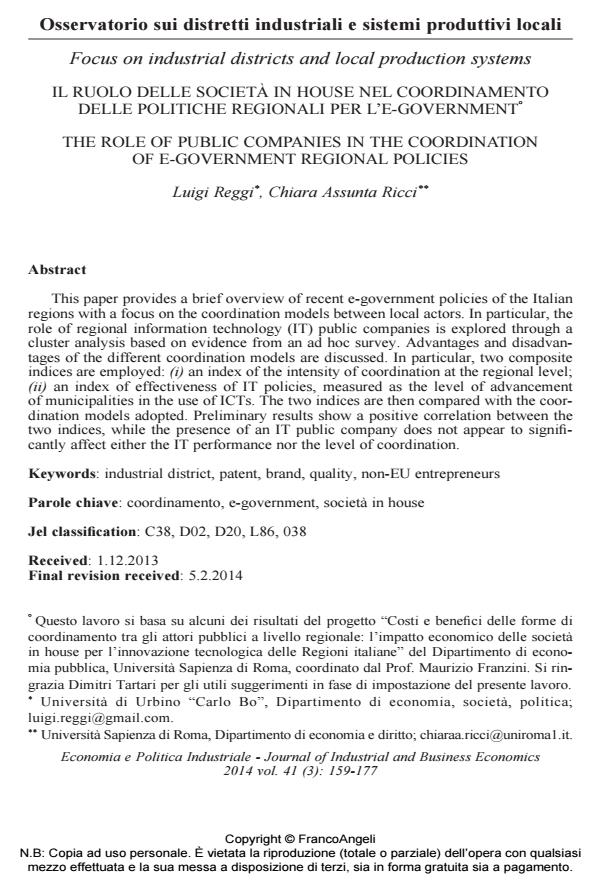Il ruolo delle società in house nel coordinamento delle politiche regionali per l’e-government
Titolo Rivista ECONOMIA E POLITICA INDUSTRIALE
Autori/Curatori Luigi Reggi, Chiara Assunta Ricci
Anno di pubblicazione 2014 Fascicolo 2014/3 Lingua Italiano
Numero pagine 19 P. 159-177 Dimensione file 91 KB
DOI 10.3280/POLI2014-003007
Il DOI è il codice a barre della proprietà intellettuale: per saperne di più
clicca qui
Qui sotto puoi vedere in anteprima la prima pagina di questo articolo.
Se questo articolo ti interessa, lo puoi acquistare (e scaricare in formato pdf) seguendo le facili indicazioni per acquistare il download credit. Acquista Download Credits per scaricare questo Articolo in formato PDF

FrancoAngeli è membro della Publishers International Linking Association, Inc (PILA)associazione indipendente e non profit per facilitare (attraverso i servizi tecnologici implementati da CrossRef.org) l’accesso degli studiosi ai contenuti digitali nelle pubblicazioni professionali e scientifiche
This paper provides a brief overview of recent e-government policies of the Italian regions with a focus on the coordination models between local actors. In particular, the role of regional information technology (IT) public companies is explored through a cluster analysis based on evidence from an ad hoc survey. Advantages and disadvantages of the different coordination models are discussed. In particular, two composite indices are employed: (i) an index of the intensity of coordination at the regional level; (ii) an index of effectiveness of IT policies, measured as the level of advancement of municipalities in the use of ICTs. The two indices are then compared with the coordination models adopted. Preliminary results show a positive correlation between the two indices, while the presence of an IT public company does not appear to significantly affect either the IT performance nor the level of coordination.;
Keywords:Coordinamento, e-government, società in house
Jel codes:C38, D02, D20, L86, 038
- Bowles S. 2004. Microeconomics: Behavior, Institutions, and Evolution. Princeton University Press: Princeton.
- CNIPA-CRC. 2008. La disponibilità dei servizi di e-government a livello locale. Osservatorio Servizi on line: Roma.
- Cooke P., Uranga M.G., Etxebarria G. 1997. Regional innovation systems: institutional and organisational dimensions. Research Policy, 26 (4-5): 475-491, DOI: 10.1016/S0048-7333(97)00025-5
- Dawes S.S. 1996. Interagency information sharing: expected benefits, manageable risks. Journal of Policy Analysis and Management, 15 (3): 377-394, DOI: 10.1002/(SICI)1520-6688(199622)
- Debreu G. 1959. The Theory of Value: An Axiomatic Analysis of Economic Equilibrium. Yale University Press: New Haven-London.
- Ferro E., Cantamessa M., Paolucci E. 2004. Economies of scale in e-government: time for evidence, in Traunmüller R. (ed.) Electronic Government. Springer-Verlag: Berlin-Heidelberg, DOI: 10.1007/978-3-540-30078-6_29
- Ferro E., Sorrentino M. 2010. Can intermunicipal collaboration help the diffusion of egovernment in peripheral areas? Evidence From Italy. Government Information Quarterly, 27 (1): 17-25, DOI: 10.1016/j.giq.2009.07.005
- Fountain J.E. 2001. Building the Virtual State. Information Technology and Institutional Change. Brookings Institution Press: Washington.
- Gil-Garcia J.R., Chengalur-Smith I., Duchessi P. 2007. Collaborative e-government: impediments and benefits of information-sharing projects in the public sector. European Journal of Information Systems, 16 (2): 121-133.
- Hulst R., Montfort A., Haveri A., Airaksinen J., Kelly J. 2009. Institutional shifts in inter-municipal service delivery. Public Organization Review, 9 (3): 263-285.
- Huxham C. 1993. Collaborative capability: an intraorganizational perspective on collaborative advantage. Public Money & Management, 13 (3): 21-28.
- Mayer-Schönberger V., Lazer D. (eds.) 2007. Governance and Information Technology. From Electronic Government to Information Government. MIT Press: Cambridge (Mass.).
- Ministero dello sviluppo economico. 2009. Migliorare le politiche di ricerca e innovazione sui fondi strutturali. Contenuti e processi di policy. Dipartimento per le politiche di sviluppo e coesione: Roma.
- OECD. 2007. E-Government as a Tool for Transformation. OECD: Paris.
- Pardo T.A., Tayi G.K. 2007. Interorganizational information integration: a key enabler for digital government. Government Information Quarterly, 24 (4): 691-715, DOI: 10.1016/j.giq.2007.08.004
- Pressman J., Wildavsky A. 1984. Implementation. University of California Press: Berkeley.
- Reggi L. 2009. Il problema della PA digitale è la governance. Menabò di Etica ed Economia, published online.
- Reggi L., Arduini D., Biagetti M., Zanfei A. 2012. How advanced are Italian regions in terms of public e-services. The construction of a composite indicator to analyze patterns of innovation in the public sector. Paper presented at the 1st International EIBURS-TAIPS Conference on Innovation in the Public Sector and the Development of E-Services. Urbino, 19-20 aprile.
- Sorrentino M., Simonetta M., Bramati L. 2010. Can mandates shape inter-municipal collaboration? The Lombardy case. WOA 2010/TRACK 1 collaborative networks, knowledge and innovation: organizational and strategic issue. Paper presentato al XI workshop dei docenti e dei ricercatori di organizzazione aziendale Incertezza, creatività e razionalità organizzative. Bologna, 16-18 giugno.
- Stiglitz J.E. 1989. Imperfect information in the product market, in Schmalensee R., Willig R. (eds.) Handbook of Industrial Organization. Elsevier: Amsterdam.
- Tartari D., Mancini M., Milioli M.A., Zani S., Cerioli A. 2007. Analisi multivariate per la valutazione delle politiche di e-government nei comuni dell’Emilia Romagna. Rivista di Economia e Statistica del Territorio, 3: 7-24.
- Tartari D., Garavini G., Lotti S. 2008. La telematica in Emilia-Romagna: obiettivi, strategie e strumenti di governance. Le Istituzioni del Federalismo, 2: 271.
- Themistocleous M., Irani Z. 2003. Towards a novel framework for the assessment of enterprise application integration packages. Paper presented at the 36th Annual Hawaii International Conference on System Sciences (HICSS’03). Hawaii, January 6-9.
- Van de Ven A.H., Delbeq A.L., Koeing R. 1976. Determinants of coordination modes within organizations. American Sociological Review, 41 (3): 322-338.
- Weiss J.A. 1987. Pathways to cooperation among public agencies. Journal of Policy Analysis and Management, 7 (1): 94-117, DOI: 10.2307/3323353
- Institutional logics and organizational change: the role of place and time Diego Ponte, Caterina Pesci, in Journal of Management and Governance /2022 pp.891
DOI: 10.1007/s10997-021-09578-6
Luigi Reggi, Chiara Assunta Ricci, Il ruolo delle società in house nel coordinamento delle politiche regionali per l’e-government in "ECONOMIA E POLITICA INDUSTRIALE " 3/2014, pp 159-177, DOI: 10.3280/POLI2014-003007